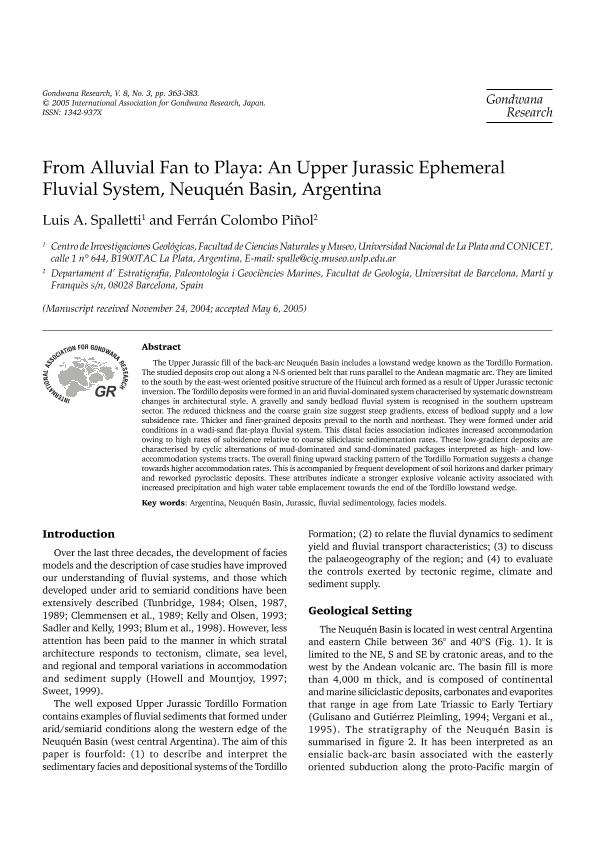Mostrar el registro sencillo del ítem
dc.contributor.author
Spalletti, Luis Antonio

dc.contributor.author
Colombo Piñol, Ferran

dc.date.available
2019-04-26T18:23:44Z
dc.date.issued
2005-12
dc.identifier.citation
Spalletti, Luis Antonio; Colombo Piñol, Ferran; From alluvial fan to playa: an Upper Jurassic ephemeral fluvial system, Neuquén Basin, Argentina; Elsevier Science; Gondwana Research; 8; 3; 12-2005; 363-383
dc.identifier.issn
1342-937X
dc.identifier.uri
http://hdl.handle.net/11336/75131
dc.description.abstract
The Upper Jurassic fill of the back-arc Neuquén Basin includes a lowstand wedge known as the Tordillo Formation. The studied deposits crop out along a N-S to oriented belt that runs parallel to the Andean magmatic arc. They are limited to the south by the east-west oriented positive structure of the Huincul arch formed as a result of Upper Jurassic tectonic inversion. The Tordillo deposits were formed in an and fluvial-dominated system characterised by systematic downstream changes in architectural style. A gravelly and sandy bedload fluvial system is recognised in the southern upstream sector. The reduced thickness and the coarse grain size suggest steep gradients, excess of bedload supply and a low subsidence rate. Thicker and finer-grained deposits prevail to the north and northeast. They were formed under arid conditions in a wadi-sand flat-playa fluvial system. This distal facies association indicates increased accommodation owing to high rates of subsidence relative to coarse siliciclastic sedimentation rates. These low-gradient deposits are characterised by cyclic alternations of mud-dominated and sand-dominated packages interpreted as high- and low-accommodation systems tracts. The overall fining upward stacking pattern of the Tordillo Formation suggests a change towards higher accommodation rates. This is accompanied by frequent development of soil horizons and darker primary and reworked pyroclastic deposits. These attributes indicate a stronger explosive volcanic activity associated with increased precipitation and high water table emplacement towards the end of the Tordillo lowstand wedge. © 2005 International Association for Gondwana Research, Japan.
dc.format
application/pdf
dc.language.iso
eng
dc.publisher
Elsevier Science

dc.rights
info:eu-repo/semantics/openAccess
dc.rights.uri
https://creativecommons.org/licenses/by-nc-sa/2.5/ar/
dc.subject
Argentina
dc.subject
Facies Models
dc.subject
Fluvial Sedimentology
dc.subject
Jurassic
dc.subject
Neuquen Basin
dc.subject.classification
Geología

dc.subject.classification
Ciencias de la Tierra y relacionadas con el Medio Ambiente

dc.subject.classification
CIENCIAS NATURALES Y EXACTAS

dc.title
From alluvial fan to playa: an Upper Jurassic ephemeral fluvial system, Neuquén Basin, Argentina
dc.type
info:eu-repo/semantics/article
dc.type
info:ar-repo/semantics/artículo
dc.type
info:eu-repo/semantics/publishedVersion
dc.date.updated
2019-04-22T15:06:17Z
dc.journal.volume
8
dc.journal.number
3
dc.journal.pagination
363-383
dc.journal.pais
Países Bajos

dc.journal.ciudad
Amsterdam
dc.description.fil
Fil: Spalletti, Luis Antonio. Consejo Nacional de Investigaciones Científicas y Técnicas. Centro Científico Tecnológico Conicet - La Plata. Centro de Investigaciones Geológicas. Universidad Nacional de La Plata. Facultad de Ciencias Naturales y Museo. Centro de Investigaciones Geológicas; Argentina
dc.description.fil
Fil: Colombo Piñol, Ferran. Universidad de Barcelona; España
dc.journal.title
Gondwana Research

dc.relation.alternativeid
info:eu-repo/semantics/altIdentifier/doi/http://dx.doi.org/10.1016/S1342-937X(05)71141-2
dc.relation.alternativeid
info:eu-repo/semantics/altIdentifier/url/https://www.sciencedirect.com/science/article/pii/S1342937X05711412
Archivos asociados
